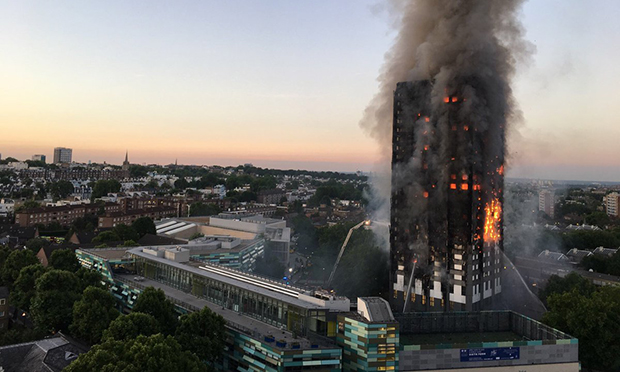Grenfell: Confusion as experts contradict Hackney Council on Fire Risk Assessment gaps

Grenfell Tower fire. Photograph: Natalie Oxford via Twitter
Safety experts have contradicted the Town Hall’s explanation for why Fire Risk Assessments (FRAs) for several of its housing blocks appear to be out of date.
Mayor Philip Glanville told residents on the day of the Grenfell fire that FRAs for all of Hackney’s tower blocks were “up to date”.
The Town Hall’s website says FRAs “can take place every few months to two years” – a point echoed by Housing Services chief Michael Scorer in a recent cabinet paper.
But many of the FRAs published on the council’s map show a gap of up to four years since the ‘Date of Previous Survey’ listed in the document.
When quizzed by the Citizen, a Hackney Council spokesperson said: “The date given under ‘date of previous survey’ isn’t actually the last time an FRA was carried out on the property – it was the last time this particular contractor carried out an FRA at the property.
“We appreciate that this could be confusing, and as part of our wider fire safety review we will be considering the presentation of FRAs.”
But when the Citizen spoke to Stephen Burrows, the assessor who carried out many of the FRAs in question, he said: “The date of previous survey is the last date I was able to source for any FRA on that building, by any contractor.”
He said that, in most cases, it “would not be me or my company that carried out the previous survey”.
Colin Todd, who helped create the widely-used FRA guidelines, PAS 79, explained: “Say an FRA is carried out in 2015 by Party A, and one is carried out in 2016 by Party B. Then Party A comes back to do an FRA in 2017. Which FRA should they list under ‘Date of Previous Survey’? The FRA carried out by Party B in 2016.
“Previous FRA refers to the building, not the assessor.”
When asked how the dates are normally sourced, Todd added: “Assessors simply ask the client, who should have a record of all FRAs carried out on their buildings.”
Burrows said he has access to a database that includes information about previous surveys, including those carried out by other contractors.
The assessor, who has decades of experience in fire safety, said he called the council immediately after he was contacted by the Citizen for the first time.
He added: “I stand by those FRAs, but any further queries need to go through the council. I don’t want to put myself in a position where it is my word against theirs.
“They have their own, corporate line on the FRAs, so it’s best to go through them from now on.”
The council later explained that any database Burrows has access to is not the council’s, and would therefore only contain information about FRAs carried out by his own company, not those by other contractors.
When asked why Burrows did not have access to the council database when filling in the previous survey dates, the spokesperson said: “Before the Grenfell fire, the view from the London Fire Brigade (LFB) was that FRAs shouldn’t be referred to when carrying out a new assessment as each assessment should be completed on its own merit.
“However, following the fire, the LFB are advising that there should be a system so previous FRAs can be referred to when carrying out assessments. We’re now working on a new system which will make it much easier to retrieve FRAs.”
The council provided what it claims are the actual dates on which the previous surveys were carried out for several tower blocks, but has so far refused requests from the Citizen to publish any other than the most recent FRAs.
Without documentary evidence of the previous surveys, and the dates on which they took place, the Citizen has not yet been able to verify the council’s claim that all FRAs are “up to date”.
The council spokesperson added: “Our staff are continuing to work flat out to make sure we’re doing all we can to ensure our properties are fire safe.
“As we’ve previously explained, FRAs are not perfect but we understand that they provide a level of insight into properties, which is why we’ve taken the unusual step of publishing them online as part of our work to reassure residents about the safety of their homes.”
